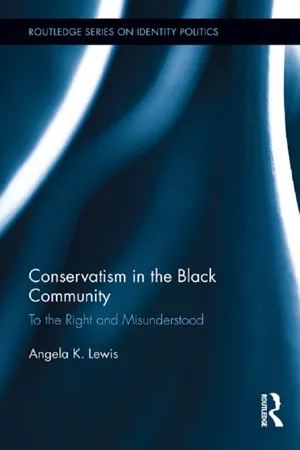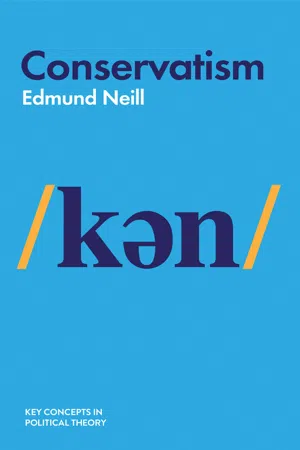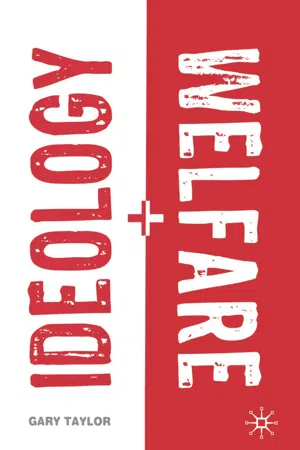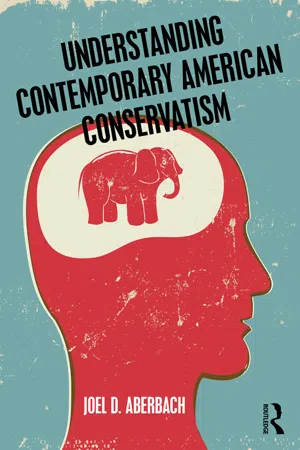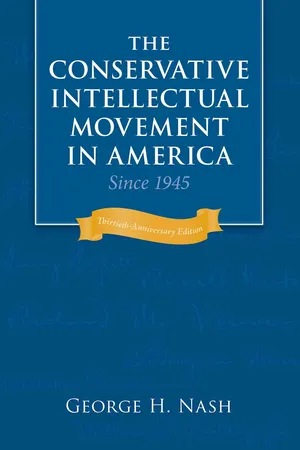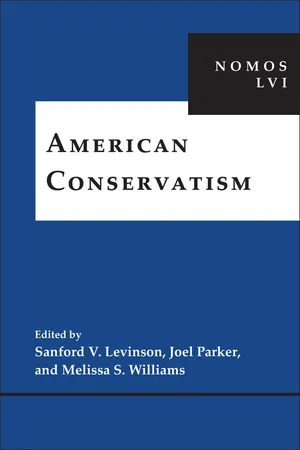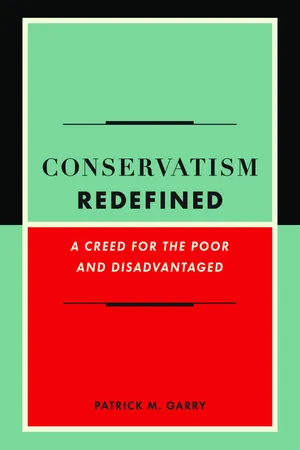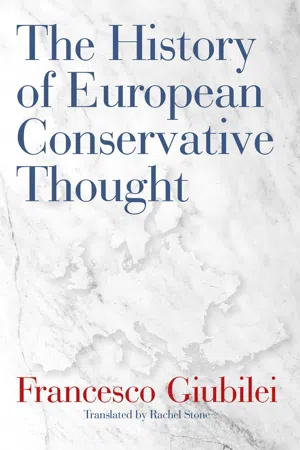History
Conservatism in the United States
Conservatism in the United States is a political and social philosophy that emphasizes traditional values, limited government intervention, free market capitalism, and a strong national defense. It has been a significant force in American politics, advocating for individual liberty, personal responsibility, and a strict interpretation of the Constitution. Conservative principles have influenced policies on issues such as taxation, healthcare, and immigration.
Written by Perlego with AI-assistance
Related key terms
Related key terms
1 of 4
Related key terms
1 of 3
11 Key excerpts on "Conservatism in the United States"
- eBook - ePub
Conservatism in the Black Community
To the Right and Misunderstood
- Angela K. Lewis(Author)
- 2013(Publication Date)
- Routledge(Publisher)
Because the focus of this book is conservatism among Blacks, I do not spend a significant amount of time discussing conservatism in America. However, it is necessary to provide the reader with a basic understanding of conservatism. Completely understanding the entire realm of conservative thought is too large a task for this text and would shift the focus of the book away from what I am theoretically interested in studying, black conservatism. Moreover, conservatism as an academic study is largely immature, fractured, and inconclusive (Smith 2010). Nonetheless, this work seeks to provide a basic understanding of conservatism in America and its development as a political philosophy. The most basic way to begin this exercise is to provide a simple definition of conservatism. Scholars suggest that “conservatives are consistently opposed to governmental regulation of the economy and civil rights legislation, and in favor of state over federal action, fiscal responsibility and decreased governmental spending and lower taxes” (Tate and Randolph 2002, 1). Conservatism also demonstrates a strong resistance to government involvement in domestic aff airs. In addition, conservatism strongly supports economic individualism, a strong defense establishment, and traditional social values. Most scholars would agree that conservatives have a desire to conserve something, usually traditions, or a way of life. However, there are diff erences in what conservatives want to conserve and how they plan to conserve it. For example, there are four streams of conservatism in America, individualist, classical, neoconservatives, and the new right, which are discussed in more detail later in this chapter. However, for illustrative purposes each of these types of conservatives have diff erent objectives. Both classical conservatives and the new right are concerned with the moral fabric of the country and are accepting of utilizing government policy for conserving traditional family values. On the other hand, individualists are opposed to government restriction on individual freedom.ConservatismConservative thought in America evolved from a tradition rooted in 18th-century political thought. Generally, conservatives agree that human imperfection is the primary cause of the current human condition. Conservatives are distrustful of human nature, and they believe that humans primarily act in their own self-interest. Conservatives also believe that human institutions, culture, and trends contribute to the human condition. However, humans acting in their own self-interest, through government, are the primary cause of our condition, a view derived from the work of Edmund Burke, the founding father of conservatism. At the core of conservative thought is the idea that individuals are flawed and self-interested and that government is needed to control and restrain individuals and to maintain order, peace, and morality (Ball and Dagger 1991). - eBook - ePub
- Edmund Neill(Author)
- 2021(Publication Date)
- Polity(Publisher)
1 Defining ConservatismThis book seeks to define the concept of conservatism and to explore its nature in the context of Western Europe and America, primarily looking at Britain, France and the United States. At first sight, this might appear to be a relatively simple task. For unlike some of the vaguer, more contested concepts in political theory, such as nationalism, populism or fascism, conservatism appears to have a relatively fixed and stable meaning. In particular, theorists investigating conservatism have often argued that conservatives advocate four key political commitments. First, they have argued that conservatives favour the importance of ‘natural’ forms of authority, such as the monarchy, the church, the nation and the family to guarantee social stability – as opposed to artificially designed ‘rationalist’ ones, particularly those provided by government. Second, relatedly, they have maintained that conservatives advocate ‘evolution’ over ‘revolution’, preferring incremental change over producing solutions from scratch, even if existing institutions are far from ideal. Third, such theorists have claimed that conservatives often consider human nature to be imperfect and fallible, with the result that they hold human inequality to be beneficial, or at the very least inevitable. Finally, within these limits, they have argued that conservatives often stress the importance of private property and capitalism in promoting individual freedom.1The Challenge of Defining Conservatism
In fact, however, as soon as one considers the concept of conservatism more closely, it throws up difficult definitional and conceptual challenges. For although some thinkers usually described as ‘conservatives’ have upheld the four commitments just described, others have not necessarily advocated all of them, or even, in some cases, any of them (Eatwell and O’Sullivan 1989: 47–61). First, although conservatives have often argued that traditional forms of authority are important, even those that have done so have not necessarily denied the importance of the state. Thus, Roger Scruton in The Meaning of Conservatism (1980), to take one modern example, was quite happy to stress the importance of governmental authority and the rule of law, as well as highlighting the vital role of traditional institutions like the family in ensuring social solidarity (Scruton 2001: 39–41). Still less, in any case, have conservatives agreed on which - eBook - ePub
Selfish Libertarians and Socialist Conservatives?
The Foundations of the Libertarian-Conservative Debate
- Nathan W. Schlueter, Nikolai G. Wenzel(Authors)
- 2016(Publication Date)
- Stanford Economics and Finance(Publisher)
CHAPTER ONE What Is Conservatism? NATHAN SCHLUETERTHE QUESTION OF THIS TITLE presents formidable difficulties. Unlike libertarianism, conservatism is not a specific philosophy of government but a generic term that can have a wide range of specific meanings, depending on context. A Muslim conservative is not the same as a Catholic conservative or a Chinese conservative; a European conservative is not the same thing as an American conservative, and, within America, a paleoconservative is not the same as a neoconservative. Conservatism, whatever its form, is bound up with historical particularity.But this does not necessarily mean that conservatism is completely bound by historical particularity, for there are moments in history when human beings seek to discover and protect transhistorical principles of right. Such moments characterize the history of the West, from the discovery of philosophy in ancient Greece, to Roman republicanism, to patristic and scholastic Christianity, to classical liberalism. Although these moments did not unfold into one another in any smooth, organic, and uncomplicated way, there is an undeniable continuity between them such that one may legitimately speak of a Western philosophical and political tradition.1 Conservatism seeks to “conserve” the best elements of that tradition.But while this is true of the conservatism I wish to defend here, the account is far too broad to be of much use in the conservative–libertarian debate. We must begin by narrowing the lens to the specific historical context in which the libertarian–conservative debate originated. That context is post–World War II America. This is not to deny that the debate has much deeper historical roots than this period or that elements of the debate transcend historical particularities (both of these propositions are evidently true, and I will say more about them in what follows), but focusing on this period will help highlight the issues in this debate. In doing so, I am largely following George H. Nash’s strategy in his magisterial The Conservative Intellectual Movement in America - eBook - ePub
- Gary Taylor(Author)
- 2006(Publication Date)
- Bloomsbury Academic(Publisher)
3
Conservatism
Conservatives are less prone than social liberals to rely upon the state to address and solve social problems through direct intervention in the economic and social systems. Whereas some liberals have put forward reasonably radical proposals, conservatives talk about the importance of preserving what we have and protecting our cherished traditions from unfamiliar and untried political schemes. This is not to say that conservatives are against all change. Conservatives often argue that slow and methodical social reform is necessary to preserve the fundamentals of the existing order and to reduce the appeal of revolutionary ideas and movements (see Kendall, 1963; Macmillan, 1966). Although this chapter will make use of some international examples, it will concentrate in the main on conservative ideas and movements in Britain and the United States. We will take a look at the ideas of theorists from the eighteenth and nineteenth centuries including Edmund Burke, Thomas Carlyle, John Ruskin and Matthew Arnold. Key British conservatives like Iain Gilmour, Harold Macmillan and Lord Hailsham will have a central place in the chapter alongside some American theorists. In addition to covering these theoretical developments, key conservative administrations will be discussed. These include the Macmillan governments in Britain and the Eisenhower, Nixon and George W. Bush administrations in the United States.Economy
Although it might be tempting to believe that conservatives are arch defenders of the capitalist system, there is a deeply ingrained sense of scepticism (and almost disdain) for the capitalist cash-nexus in significant strands of the conservative tradition. Many of the more traditional conservatives wish to conserve social hierarchies and they often hold culture and national characteristics in far higher regard than the mere pursuit of profit. Cultural conservatives of the nineteenth century were particularly critical of capitalism and of its liberal defenders. John Ruskin (1862) was convinced that liberal political economy paid too little attention to our non-economic needs and focussed our attention far too much upon the accumulation of riches. For Ruskin, we should be more mindful of the qualitative nature of real wealth and be willing to sacrifice ‘economic success’ in the interests of enriching our spiritual lives. For Thomas Carlyle (1843) politicians should, in the interests of social order and of restoring a natural balance to society, seek to cultivate benevolent relations between workers and management. In his view, the political economy of the classical liberals was inhumane and needed to be tempered by compassion, understanding and benevolence. Although these observations might seem rather quaint and were certainly at odds with the hard-nosed business ethics of the nineteenth century, they captured at least some of the conservative dissatisfaction with the profit motive and with reducing politics to the defence of an amoral economic system. - eBook - ePub
- Joel Aberbach(Author)
- 2016(Publication Date)
- Routledge(Publisher)
1 Contemporary American Conservatism as a Legacy of the 1960s An Introduction DOI: 10.4324/9781315563381-1From the vantage point of 2016 American conservatism and what is loosely called the American conservative movement (a mélange of ideas, people and organizations) looks like a behemoth, though an often ungainly and troubled one. While the last president conservatives backed left office in 2009, the conservative movement is well financed, has huge influence in the Republican Party, has followers throughout the land, and has a network of think tanks and media outlets that are the envy of its competitors. But it was not always such. Indeed, in 1964 it appeared American conservatism had failed a major test and might be headed for the dustbin of history. However, following the scorching defeat of Barry Goldwater in the 1964 election there emerged a strong conservative movement and a reinvigorated Republican Party that won seven of the next fourteen presidential elections and in 1994 took over both houses of Congress for the first time in many years, and has continued to control at least one house of Congress for much of the period since. This book examines what made all this possible and what contemporary conservatism means for the United States. It focuses on how prominent identification as a conservative is in the United States, what people who call themselves conservatives believe, and how the structure of conservative beliefs has evolved over time.Perhaps the most famous line written by the conservative William F. Buckley, Jr. appeared in the inaugural issue of National Review (1955). Buckley said of his newly-born magazine: “It stands athwart history yelling Stop.”1 At the time, few but the small circle around Buckley thought that conservatism would achieve its current position in American politics, and probably fewer still thought that it would develop in the ways that it has. Inside of a decade, the conservatives’ favorite (Senator Goldwater) won the Republican nomination for President, lost the election in a landslide, and then the conservative movement came roaring back, reaching high points (or low points, if one disagreed with its thrusts) in the administrations of Ronald Reagan and George W. Bush. While conservatism has hardly achieved a smaller state – compare the expenditures of the American government at the start and end of the Reagan administration (Federal outlays in 1981 were $679.2 billion and they were $1,064.4 billion in 1988) and then at the start and end of the administration of George W. Bush ($1,862.8 billion in 2001 and $2,982.5 billion in 2008)2 - George H. Nash(Author)
- 2023(Publication Date)
- Regnery Gateway(Publisher)
What Is Conservatism in America? The Search for a Viable HeritageA s if the search for theoretical harmony were not by itself sufficiently perplexing, conservative intellectuals faced another challenging problem in the late 1950s and early 1960s: the relation of their philosophy to the American environment. In the first decade after 1945—the years of initial protest and ferment—articulate conservatives had been relatively unconcerned with the specifically American features of the heritage they wished to defend. Traditionalists or new conservatives, shocked by totalitarian mass man and mass society, had often looked to Europeans like Burke, Metternich, Ortega y Gasset, and T. S. Eliot for moral and intellectual instruction, a tendency reinforced by the impact of European émigrés on the American conservative renascence. When they did examine the America around them, traditionalists were frequently repelled by its burgeoning “crowd culture.” Libertarians, too, felt beleaguered in America and turned to Europeans like Friedrich Hayek, Ludwig von Mises, and Wilhelm Röpke. They, too, were often burdened with the feeling of being a forlorn Nockian Remnant in a nation following a New Deal–Fair Deal Pied Piper into the darkening world of the Total State. Even some of the former Communists who gave the conservative movement its crusading fervor seemed at first little interested in America as America. Instead, they tended to perceive the United States as a world power, the only logical leader of the worldwide struggle against messianic Communism. From such a perspective, America’s domestic problems were much less important than the Third World War.It is not entirely surprising, therefore, that many left-of-center observers soon insisted, and insisted repeatedly, that the postwar Right was “un-American,” peculiarly foreign to the American experience. Undoubtedly the most influential example of this line of criticism was Louis Hartz’s The Liberal Tradition in America, published in 1955. According to Hartz, “Lockean” liberalism was virtually the only tradition in America; conservatism, which he equated with feudalism and hierarchy, had never been truly indigenous. After all, America had lacked a feudal social structure and, consequently, the ideology appropriate to it. In one way or another, a horde of critics elaborated on the same theme. In 1957 Richard Chase argued that a “discontinuity” existed in America between conservative feelings and liberal ideas; our principal literature, while exhibiting conservative sentiments, nevertheless advanced liberAlthoughts.1 In 1962 Elisha Greifer, examining the quest of Henry and Brooks Adams for a “pre-liberal past,” concluded that they had not found one. Why? Because it did not exist. There was only one American tradition—the liberal tradition—and conservatism was forever doomed to be an “exotic import.”2- eBook - ePub
American Conservatism
NOMOS LVI
- Sanford V. Levinson, Melissa S. Williams, Joel Parker(Authors)
- 2016(Publication Date)
- NYU Press(Publisher)
Through this all-too-brief encapsulation of the anti-conservative features of liberalism, one can perhaps readily discern that the “correlative opposites” discussed in Sidorsky’s exposition of conservatism’s critique of modern concepts of liberty, equality, and fraternity are, at least problematically, and perhaps finally not at all, conservative. This should not prove surprising, since the United States is the world’s consummately liberal nation. Its founding documents—particularly the Declaration of Independence—are based upon the Lockean thesis justifying revolution against an illegitimate government. It has been boasted as the most dynamic free-market economy in the history of the world, and has been the uncontested engine of globalization and internationalism in the history of the world. One can hardly think of a less “conservative” nation that the United States of America, and must wonder whether there is any appreciable conservative presence in such a nation. Sidorsky’s analysis suggests that there may not be.The three elements comprising modern American conservatism suggests that one is hard pressed to find “conservatism” within the broader context of American liberalism, and, in particular, that American “conservatism” only gains political traction inasmuch as it conforms with dominant liberal norms and assumptions. The three constituting elements of the modern conservative movement, to which Sidorsky rightly points—echoing precisely the “fusion” that was consciously formed at the outset of the modern conservative movement in America by such early founders as William F. Buckley and Frank Meyer—are: (1) Economic libertarians; (2) “National Security” conservatives; and (3) Social conservatives. The first often invoked the ideas of Milton Friedman, Friedrich Hayek, and Ayn Rand for inspiration and overlapped with the other two in their criticisms of an enlarged and activist federal government and their opposition to Communism. The second group, in many cases, were anti-communist liberals (such as Irving Kristol), whose antipathy to Communism led them to embrace the conservative cause. In their more recent iteration, they are known as “neoconservatives,” counting among their number William Kristol. The last group is mainly composed of traditionalist Christians and orthodox Jews—a broad coalition of Evangelical Protestants, traditional Roman Catholics, and a smaller number of conservative mainline Protestants, Mormons, orthodox Jews, and Christian Orthodox. For a time they were gathered under the banner “Moral Majority” and gained an intellectual home at the ecumenical journal First Things - eBook - ePub
The Conservative Challenge to Globalization
Anglo-American Perspectives
- Ray Kiely(Author)
- 2020(Publication Date)
- Agenda Publishing(Publisher)
7 .The chapter starts by discussing how conservatism developed in the US in the period before 1945. It particularly outlines conservatism’s seemingly ambiguous relationship with capitalism, and especially its antagonism to liberalism, socialism and “mass society”. The second section then examines the development of conservatism after 1945, particularly the development of a postwar American conservatism that essentially made its peace with capitalism, and in its neoconservative form essentially allied itself with neoliberalism from the 1960s onwards. The third section examines alternative conservative thought in the US and specifically the paleoconservative tradition, which is hostile to neoconservatism and indeed to globalization. Finally, the fourth section examines the links between different strands of conservative thought and the rise of the Trump phenomenon. This will look in particular at the question of what Trump stood for during his presidential campaign, and in developing some of the themes discussed in the last section of the previous chapter will look at the social basis of support for Trump and the rise of anti-globalization resentment. I will also make some preliminary observations about the relationship of paleoconservatism to other American conservative traditions, and in particular to neoliberalism and how this is linked to the question of resentment.Conservatism in America (and elsewhere) before 1945Louis Hartz (1991 ) famously argued that in the absence of a monarchy, a feudal order and an established Church, there is no conservative tradition in the US. This argument is further reinforced by the fact that industrialization and (limited) democracy evolved together, and there has been no lasting socialist tradition to threaten the liberal order. On the other hand, the constitution was designed, in part, not only to provide checks and balances between different branches of government, but also to ensure state rights for minorities and an electoral college that would supposedly ensure that no tyrant could emerge to manipulate the democratic masses. But it was also clear that the electoral college quickly developed in such a way that local state rights amounted to a defence of the practice of slavery in the South. Moreover, the agrarian South established a conservative tradition in the context of slavery and, after abolition, through the promotion of an authentic Southern order, which contrasted to the commercialism of the North. In the nineteenth century, the case for slavery was made, above all by George Fitzhugh and John Calhoun. The former, in his 1854 work Sociology for the South: or the Failure of Free Society, argued that slavery was based on a paternalist social order where slave-owners felt a moral obligation towards their slaves. In contrast, liberal economies left people atomized and isolated, and wage slavery left no social obligation on the part of employers to their employees. Indeed, slavery was “a beautiful example of communism, where each one receives not according to his labour, but according to his wants” (Fitzhugh 2013 : 29). John Calhoun, who from 1825 to 1832 was vice president of the US, made the case for local state rights in the face of majority votes at the federal level, an argument that laid the ground for Southern secession in 1860–1 and thus the Civil War. The case for states’ rights has since regularly been made, including in the period after the Civil War and the failure of reconstruction in the Southern states, and the institutionalization of racism in the South from the 1880s and 1890s onwards. This Southern tradition was one of the first examples of American conservatism. This conservatism around slavery and the post-1865 order was based on the idea that this was a natural order and any attempt to undermine it would lead to the end of social cohesion and the promotion of more radical ideas, such as those taking place in Europe in 1848 (Kolozi 2017 - eBook - ePub
Conservatism Redefined
A Creed for the Poor and Disadvantaged
- Patrick Garry(Author)
- 2010(Publication Date)
- Encounter Books(Publisher)
CHAPTER ONETHE ENDURING POWER OF CONSERVATISMIt can be difficult to truly appreciate the nature of the conservative philosophy, which often gets intermingled with Republican Party politics, regardless of whether those politics accurately reflect conservative ideas. Certainly nothing in the conservative creed, for instance, envisions the kind of federal budget deficits that have arisen since 2001. But the sinking ship of the Bush presidency took down with it all other boats in its vicinity, one of which was political conservatism. As a result, pollsters and pundits, beginning in the final years of the Bush presidency, started declaring the death of conservative politics in America. However, such predictions have been made before, during a period when conservatism faced an even greater crisis than it does now—and out of that period conservatism emerged stronger than it had ever been. Thus, a look back at the struggles of conservatism during the 1960s and 1970s will reveal its enduring strength.The most illuminating time to judge a belief may be when it is out of favor, to see how it holds up during periods of public criticism. Values and beliefs, like people, can be best measured under adversity—because the strength of an idea can often be better tested when it is being condemned than when it is being followed.Just a half-century ago, conservatism was a decidedly unpopular and much-derided philosophy. Within mainstream political culture, conservative ideals had been marginalized since the early 1930s, following Herbert Hoover’s ineffectual response to the Great Depression. But the movement’s long hiatus from popular esteem reached a low point in the 1960s, when conservatism was seen as a permanent minority philosophy in America. In fact, it was so much in the minority that there was a question as to whether the conservative cause would even survive. But the cause did survive, and the story of how it emerged triumphant in the 1980s after a period of reexamination is a story of dogged perseverance—a story of unrelenting commitment to a set of ideals rooted in more than three centuries of American history. - eBook - ePub
- Karl Mannheim(Author)
- 2013(Publication Date)
- Routledge(Publisher)
With the appearance of an integrated conservative politics, or perhaps even somewhat earlier, a corresponding world-view and way of thinking emerge, which may be similarly classified as conservative. In our terminology and in relation to the first half of the nineteenth century, then, ‘conservative’ and ‘liberal’ refer to quite specific affinities to distinctive philosophies and to an associated distinctiveness in the manner of thinking, and not only to distinctive political aspirations. A distinctive overall structure of the world may thus be said to be implicit in the term ‘conservative’. The sociological definition of the term, inevitably more comprehensive than the historical-political one, must necessarily also refer to that historical structural situation in which this term could arise to designate a new fact]. 65 In our view, the socio-historical precondition for the emergence of conservatism is, in brief, a conjunction of the following factors: (1) The historical social whole (Sozialkomplex) must have become explicitly dynamic (processive). Individual happenings within the totality of events must to an increasing extent be in every sphere oriented to the same set of basic questions about the growth of the social whole. This orientation to the central issues of the overall movement happens unintentionally at first; but later it will become conscious and intentional, whereupon the significance of each element for the development of the whole will become increasingly clear. There will be accordingly a steady decline in the number of the discrete, self-contained social units which had previously predominated - eBook - ePub
- Francesco Giubilei(Author)
- 2019(Publication Date)
- Regnery Gateway(Publisher)
The difference between reactionaries and conservatives lies in the different ways they approach the past. While a reactionary wants to return to the past by restoring previous forms of government and, with them, all the customs and dynamics that regulated that society, a conservative does not aim to conserve the entire past. Rather, conservatives aim to conserve “the natural and fundamental elements of society, which are: private property, family, the homeland, and even religion . . . the right-wing conservative is such not because he wants to conserve any regime and any institutions, but rather specific institutions and particular values.”The Differences between Conservatives, Liberals, and LibertariansToday, there is much confusion and sometimes misidentification of two distinct doctrines: liberalism and conservatism. Certain commonalities between the two are sure to be unmentioned or forgotten, whereas differences between them are substantial, undeniable, and often spoken of.To understand the differences between conservatives and liberals, one must begin with the origin of the term “liberal,” which first entered political discourse in 1812 with the Cádiz Cortes, the Spanish assembly that promulgated the constitution during the final year of the Spanish War of Independence. At this time, conservative and liberal stances were already dissociated: conservatives were in favor of maintaining an absolute monarchy, whereas liberals accepted the “Constitution of Bayonne” drafted during Napoleon’s domination, with some liberal modifications.Liberalism, as written by Giuseppe Bedeschi in Storia del pensiero liberale , is “a doctrine that affirms the limit of power of the state in the name of individual natural rights, inherent in every man.”66A clear first difference emerges from this definition: both conservatism and liberalism believe in the importance of freedom, but while liberals consider freedom the main value for men, conservatives consider it to be one of the values.Another important distinction can be found in conceptions of the individual. Liberals place individuals, and therefore individualism, at the forefront; without individualism (opposed to any form of organicism), liberalism does not exist. Conservatives, on the other hand, put community at the center. They share the same ideas about limits on the power of the state, but their ideas on how to limit that power are different. Conservatives highlight the value of intermediate bodies, whereas liberals highlight the individual.
Index pages curate the most relevant extracts from our library of academic textbooks. They’ve been created using an in-house natural language model (NLM), each adding context and meaning to key research topics.
Explore more topic indexes
Explore more topic indexes
1 of 6
Explore more topic indexes
1 of 4
